This article contains spoilers. If you read on, please be aware that surprises or secrets may be revealed in great depth
We all know what you get when you cross a dark ride with a living tableau demonstrating the ethnicity and ethos of other countries and cultures in the world - It's a Small World.
If you throw stories of jealousy and deceit into the fray of an idyllic civilisation culminating in a sweet - if predictable - happy ending you're likely to end up with an episode of Emmerdale, but sprinkle in a bit of black magic, and you're left with what should be the perfect plot for a dark ride, say, a haunted swing.
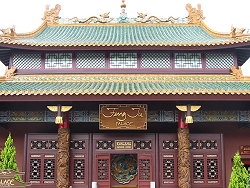 And behold - Feng Ju Palace - a story of good prevailing over evil and love triumphing over hate with a little bit of fantasy thrown in for good measure.
And behold - Feng Ju Palace - a story of good prevailing over evil and love triumphing over hate with a little bit of fantasy thrown in for good measure.
At the design stage, Feng Ju Palace was originally known as Thunder Temple, a ride that was to tell the story of five gods who co-existed in perfect harmony until one of the gods disappeared ruining the balance between them. Like Feng Ju Palace, Thunder Temple was to be a battle of good and bad, through which inevitably good would prevail and through an elaborate display of special effects you would reach a happy ending.
Using this general plot as a backbone, Feng Ju Palace uses a far more domestic, yet no less exotic backdrop of China to tell this story. And like all great stories of good versus adversity, love would be the pivotal catalyst behind this battle between two extremities of passion.
Feng Ju Palace overlooks a neatly manicured lawn festooned with bonsai and oriental topiary along with the park's flagship Chinese restaurant and the exquisitely themed Phantasialand Hotel.
Considering Asia is a well-regarded country in terms of architecture, art and culture, a surprisingly small number of parks have risen to the challenge of theming areas after Asian countries and provinces.
Chessington had an admirable stab at it a few decades ago, an effort accomplished by Port Aventura again in 1995, yet Phantasialand's is lavish, brim full of charm, and is like a swan in the midst of chickens.
Should you doubt this swan for an ugly duckling, look no further than Feng Ju Palace. The screen-fronted building is basked in shades of maroon with intricately carved solid wood pillars reaching up to a beautifully tiled roof complete with gold-trimmings and dragon gargoyles.
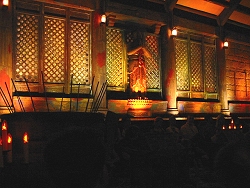 Inside, you're greeted with an enormous porcelain mosaic depicting two dragons swirling around in combat before you turn left and walk down a corridor, lit with Chinese lanterns, decorated with yet more mosaics.
Inside, you're greeted with an enormous porcelain mosaic depicting two dragons swirling around in combat before you turn left and walk down a corridor, lit with Chinese lanterns, decorated with yet more mosaics.
After a wait, the doors swing open and you enter the octagonal pre-show room. Like the rest of the building, it is beautifully decorated, lit with the subtle glow of lanterns with statues inset into four of the walls representing the four elements; earth, wind, water and fire.
Opposite the side you entered there's a stage, and as the doors shut behind you, the lights dim and as the sound of a gong echoes around the room, the pre show begins.
The pre-show introduces the main characters of Feng Ju Palace - Hsiautsai, a beautiful princess and the object of affection for Akang. Unfortunately for our friend Akang, Hsiautsai is set to marry the Demon of Hell himself, Yanluowang. Boo, hiss.
When I say the show introduces these characters, it does so on the most basic level possible. Presumably to increase international appeal, the pre-show tackles the problem of language barriers by using no dialogue what so ever.
Anyhoo, the general gist is that Yanluowang (boo, hiss) challenges our plucky friend Akang to fight for the affections of Hsiatsai. The stage erupts into a colourful display of martial arts with the two Romeos fighting it out for our pretty Juliet.
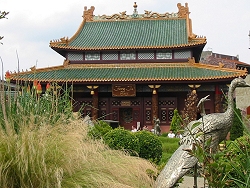 This display is all done via a projection, which is all very lar-de-dar, but let me tell you, the quality is absolutely remarkable to the point if it wasn't for the rather audacious stunts Yanluowang and Akang perform, you'd be hard pushed to even believe that there aren't real performers on stage.
This display is all done via a projection, which is all very lar-de-dar, but let me tell you, the quality is absolutely remarkable to the point if it wasn't for the rather audacious stunts Yanluowang and Akang perform, you'd be hard pushed to even believe that there aren't real performers on stage.
The fighting continues, punctuated by interceptions by the four statues depicting earth, wind, water and fire. Every so often, with a crack of thunder these statues are lit with colourful hues and come to life, animating a basic action - such as playing a pipa (oriental guitar-style instrument).
Nevertheless, the fight ends with Yanluowang the victor. The battle may be over, but the war has yet to be won as we continue deeper into the palace.
We take our seats in a large hall. Compared to the last room, the decor is far more basic, but not much less beautiful. Swathes of colour light up the stone walls and screen windows, with slender pillars reaching up to the panelled ceiling high above our wooden pews.
The hall holds nearly eighty people who sit in four rows facing the middle of the room, and once everyone is seated, the lap bars drop and the wooden doors slide shut.
The dull murmur of expectation is silenced when the sound of a gong once again echoes around the room before the battle continues. With Akang defeated, it is left to the spirits of earth, wind, fire and water to battle the evil warlord Yanluowang.
The lights dim, there's a crack of lightening and you can feel these benevolent forces at work. You are clearly moving, although there is no way to tell, and with frank words exchanged between the spirits and Yanluowang, the room begins to move around you, the whole floor seemingly a gondola moving in time to the rolling melodies of a spectacular Chinese soundtrack.
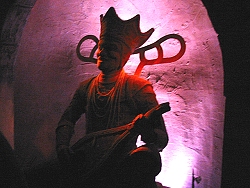 Soon, the floor becomes the ceiling, revealing a large, white expanse elevated high above your heads, lingering, before the room once again rolls around with the distant sound of wind and the flickering of lightening through the windows.
Soon, the floor becomes the ceiling, revealing a large, white expanse elevated high above your heads, lingering, before the room once again rolls around with the distant sound of wind and the flickering of lightening through the windows.
As the room tumbles around us, lights go out with a crash of thunder before once again, the room is turned upside-down and the elevated floor turns into a swirl of orange and blue clouds, the shielded face of Yanluowang vanishing into the distance and Akang and Hsiatsai running towards each other and embracing as the image fades, the music climaxes and the ride slowly but surely concludes.
So with all this said and done, this has the potential to be the best Mad House in the world. It has all the ingredients - a good story line, great theming and - something many similar rides neglect - an actual conclusive ending.
But there is quite a fundamental problem. It's actually quite boring.
I think much of the problem lies in the hands of the pre-show. In an effort to make the show multi-lingual, the show, despite it's technical achievements, it basically four minutes of fighting.
Yes, I am well aware Chinese martial arts are an artform, but considering the purpose of the pre-show is to establish the plot for the ride, as far as even German visitors are concerned, it is two grown men having a good old scrap at a young girl's expense.
Even more inexplicably, is the introduction of the four elements of earth, wind, fire and water. These aren't introduced as much - you'll only know 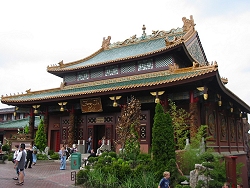 these statues' identity if you know the storyline before hand.
these statues' identity if you know the storyline before hand.
The animation of these statues is comically basic. Think It's a Small World and you have the idea. Of course, being statues, I don't expect them to get up and run across the ceiling as if they're in Crouching Tiger Hidden Dragon, and their basic animation is obviously through design, but to punctuate this high speed and dynamic fight scene with a statue with a static statue with a rotating hand (in one example) is a bizarre contrast to say the least.
Once inside the main room, the lavish scenery continues, but the ride is equally as disappointing. The lighting effects are good, although pale compared to Hex, and the flat white floor that is revealed once the ride starts moving is an unsightly intrusion.
At the end of the ride, it does serve a purpose as a projection screen, but until that point, it is like a blank canvas hung up in the Louvre - Certainly not worthy of celebration.
Mad House veterans may also be disappointed with the programme used for this Mad House. Feng Ju Palace seems to build up to a full revolution through a series of swings like any other Mad House, but leaves the room inverted twice, the first time without any real reason which exposes the white floor mentioned above for no real reason.
In between this and the finale, there is a series of fairly non-descript moves with it taking what seems an eternity to line up for the final projection before spending a surprising amount of time up-righting again at the end of the ride.
I hate to come across too negative. The theming throughout the ride is wholesome and extravagant and the music used throughout the ride wouldn't be out of place in the finest Wu Xia film. In fact, the whole ride oozes this lavish sense of fantasy as these films, yet the entire attraction is far too passive to feel completely indulged in this sense of unreality.
Please, do not use our ratings to compare rides head-to-head. They rate only how well this ride meets its own objectives using criteria that may not necessarily be relevant with similar reviews.

Good points:
- Lavish, arty and high quality throughout
- Good music and a very technically impressive pre-show
Bad points:
- Pretentious, in places dull, and without much dialogue, difficult to follow
- The pre-show is chaotic and repetitive, and the statues are in a strange contrast to the rest of the show
- The bottom of the final room is ugly until such a time as it is used as a projection screen
Labels: DarkRides, Phantasialand, Vekoma